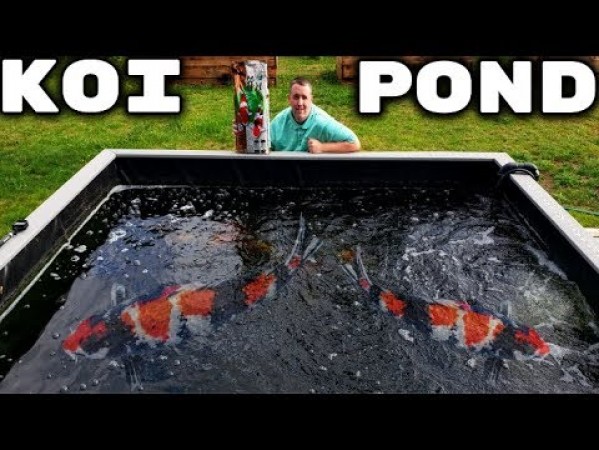Aquarium Coops Shows Off His DIY Koi Pond
- Aug 15, 2019
- Web Aggrigator
- 1683 0 0

Cory from Aquarium Co op shows off his DIY Koi Pond
Before feeding his Koi Cory goes through with a net and remove any floating debris on the surface of the pond the Koi will eat the debris, but he tries not to make then eat pine needle while they are eating the food he is about to feed them.
The pond is estimated to be about 4,000 gallons it is 10' length by 10' width and 6' deep. It is nice to have a deep pond to prevent preditors from getting to them. The Koi can quickly dive down to get away from pray. Some pray can dive into the water or if your pond is not that deep a net can be added above the pond to prevent anything from getting to the Koi.
Initially, an auto feeder was added to the system, but it did not work, so Cory is currently hand-feeding them but plans to get another auto feeder to be able to feed the Koi 4-5 times a day. The pond has several different types of Koi, including:
- Shiro Utsuri - They are black and white they have scale patterns on them, and by providing excellent quality food as they get older, you can prevent the black from turning gray or brownish in color. Ideally, you want to black to be an intense black.
- Doitsu Koi - So Doitsu Koi have no scales or limited scales, if they have scales they are commonly found along their back and sometimes down their lateral line but not much else. Due to not the limited or no scales, their color looks more like a tattoo and can produce more intense colorations.
- Matsuba Koi - The Matsuba scales are very prominent and part of the pattern
- Kohaku Koi - The Kohaku is white and red and has scales, but they are not part of the pattern.
- Kohaku Doitsu Koi - The Kohaku Doitsu is white and red, but the colors look more intense due to the limited amount of scales.
Most of Cory Koi were purchased as young Koi to reduce the cost of the Kois, with that said the average price was about $80 each. Most of the Koi came from Rosarco. Rosarco is known for farms that specialize in a single type of Koi and try to perfect that species to compere and produce award-winning Koi. This may seem expensive but fully grown quality Koi can run you as much as $10,000 for a single Koi.
When you are buying a young Koi, you want to look at the parents, and that will give you an idea of what they will look like. This is important because it will take 3-5 years to grow out the young Koi. Many things can impact the growth of the Koi such as the size of there environment, how often they are feed, is there any current in the water to force them to swim faster.
When choosing Koi, Cory focuses on adding something that he already does not have and wants to be able to look at.
While automatic feeders are nice but sometimes they can make the Koi run from people when they approach the pond. To make the Koi more friendly, Cory will feed them by hand for a more extended period. He will feed a smaller amount at a time and stay over the food so that they can associate the food with people and be attracted to them.
You want to make sure you get good quality food, the pellets Cory feeds are round, and they hold their shape even after they sink. So they do not degrade and release particles into the water that can get sucked up by the filter. This also gives the Koi a longer time to feed. If you are trying to bring out the color of the Koi you want to choose a food with daffodil there are also other natural color enhancers. You have to be careful if you have Koi's with white in them because if for instance, you are using a red color enhancer the white could start to turn pink.
Koi's colors will change with time, colors can completely disappear, and patterns can change. Especially with young Koi, they will look completely different when they become an adult, that is why it is so important to buy based off of what the parents look like to give you an idea of what they will look like.
You can get pond grade Koi fish which are Koi fish for around $10 per Koi, and this is perfect for someone who is less concerned on how the Koi will look once they get older and just wants to have some big fish in their pond.






About author
The content found on this page was found and added by Tank Facts to make it easier to learn about new species and keeping all of the found content in one place. The brand and content is owned by the respected individuals and in no way considered Tank Fact